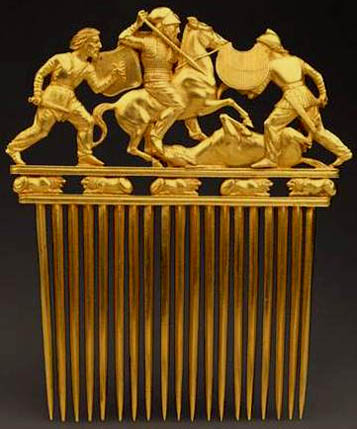
It belongs to the Hermitage Museum in St. Petersburg, Russia and usually resides in the Second Chamber of the Gold Room. It was found in 1913, when N. Veselovsky excavated the Solokha Barrow. Epic Scythian legend recounts the quarrel between three brothers seen as the founders of the Scythian tribe. The battle has been portrayed many times in different media.
Scholars feel the comb was created between the 5th and 4th Century BC, when the Scythian king was killed by his own brothers for his love of Greek culture. At some time in the first third of the 4th century BC, the comb was placed on the head of the victor, Octamasad, whose tomb was placed inside the grandiose 18 metre barrow earlier erected for his brother Orik. This tomb was robbed in Antiquity, but the comb survived.
What I find ironic is that combs are the territory of women, but this most famous one was about war and made for a man.
Barbaraanne's Hair Comb Blog
A Community of Scholars

A Greek artist friend had an interesting perspective. He felt the horizontal rails underneath the main sculpture symbolized a bridge. The lions reminded him of ornamental wallpaper.
“Conceptually, much more could have been done with them,” he said. “On each edge, a pair of lions face each other in the territorial challenge of war. For the eye, they create vertical columns that support the bridge.
However, the artist could have given the center much more philosophical significance.
Choice 1:
The center lion could have represented Octamasad by being larger, his roaring face exposed frontally, rising above the rail. This choice would have revealed why men fight wars — not for themselves, but because kings or presidents tell them to. Then the bridge would have become a metaphorical call to war.
Choice 2:
The artist could have left the center empty and chosen negative space. This would have allowed the comb to breathe, making the bridge a metaphorical call to peace.
The scale of man to horse was also not correct in his view. “The horses were the size of deer,” he said.